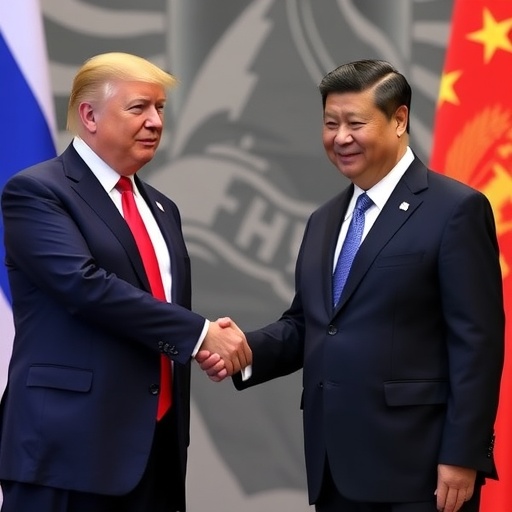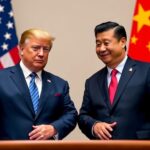Trump Seeks China’s Assistance in Russia-Ukraine Peace Deal During Critical Asia Tour Ahead of Xi Summit
In a surprising diplomatic pivot, President Donald Trump has publicly called on China to play a pivotal role in mediating peace talks with Russia over the ongoing Ukraine war, just as he launches a high-stakes five-day tour across Asia. Speaking from the White House before departing, Trump emphasized the need for Beijing’s influence in curbing Moscow’s aggression, setting the stage for his anticipated meeting with Chinese President Xi Jinping later this week. This move underscores a potential shift in U.S. strategy, leveraging economic ties with China to address the protracted conflict that has claimed thousands of lives and disrupted global markets.
- Trump’s Direct Appeal: Inviting China into Russia-Ukraine Diplomacy
- Asia Tour Itinerary: Strengthening Alliances Amid Russia Tensions
- Building Momentum for the Xi Jinping Summit: Expectations and Challenges
- Global Experts Analyze China’s Leverage Over Russia in Ukraine War
- Potential Outcomes: Reshaping U.S.-China-Russia Dynamics Post-Summit
The announcement comes amid escalating tensions in the Ukraine war, where Russian forces continue to advance in eastern regions, prompting urgent calls for international intervention. Trump’s outreach to China, a key trading partner with deep economic links to Russia, highlights the intricate web of diplomatic talks that could reshape alliances in the Indo-Pacific and beyond. As Trump boards Air Force One for stops in Malaysia, Japan, and South Korea, analysts are watching closely to see if this gambit yields breakthroughs or exposes fractures in U.S.-China relations.
Trump’s Direct Appeal: Inviting China into Russia-Ukraine Diplomacy
President Trump’s explicit request for China’s help marks a bold departure from traditional U.S. isolation of Beijing in matters concerning Russia. During a press briefing on Monday, Trump stated, “China has the leverage with Russia that we need right now. They’ve got the economic ties, the influence—let’s use it to end this Ukraine war before it spirals further.” This rhetoric reflects growing frustration in Washington over stalled diplomatic talks, where previous efforts led by European allies have faltered without broader buy-in from major powers like China.
Historically, China has maintained a neutral stance on the Ukraine war, abstaining from UN votes condemning Russia while providing economic lifelines through increased trade. In 2023 alone, bilateral trade between China and Russia surged by 26%, reaching over $240 billion, according to data from China’s General Administration of Customs. This interdependence has fueled speculation that Beijing could pressure Moscow to the negotiating table, especially if incentivized by U.S. concessions on trade tariffs or technology restrictions.
Trump’s comments build on informal backchannel discussions reported by sources familiar with the matter. Last month, U.S. envoys quietly approached Chinese diplomats in Geneva, floating ideas for a trilateral framework involving Washington, Beijing, and Moscow. While details remain classified, the proposal reportedly includes China’s potential role in guaranteeing any ceasefire agreements, drawing parallels to its mediation in the Iran nuclear deal. Critics, however, warn that involving China risks legitimizing its territorial claims in the South China Sea, complicating the diplomatic talks further.
To illustrate the stakes, consider the human cost: The Ukraine war has displaced over 6 million people and caused an estimated $500 billion in infrastructure damage, per United Nations reports. Trump’s strategy aims to harness China’s growing global clout—its Belt and Road Initiative spans 150 countries—to foster stability, potentially averting a broader energy crisis as Russian gas supplies to Europe dwindle.
Asia Tour Itinerary: Strengthening Alliances Amid Russia Tensions
Trump’s five-day Asia trip is meticulously planned to bolster key alliances while laying groundwork for the Xi meeting. Kicking off in Malaysia, a neutral Southeast Asian hub with strong ties to both the U.S. and China, Trump will address economic cooperation and regional security. Malaysia’s strategic position in the Malacca Strait, through which 80% of China’s oil imports pass, makes it an ideal venue to subtly signal U.S. interests in countering Russian influence via Chinese channels.
From there, the itinerary shifts to Japan, where Trump is expected to reaffirm the U.S.-Japan security pact amid shared concerns over the Ukraine war’s ripple effects. Japanese Prime Minister Fumio Kishida has voiced support for diplomatic talks involving China, noting in a recent interview, “Any path to peace in Ukraine must include major stakeholders like Beijing to ensure lasting results.” Discussions in Tokyo will likely touch on bolstering sanctions against Russia, with Japan having already frozen $100 billion in Russian assets since the invasion began in February 2022.
The tour culminates in South Korea, a linchpin in U.S. Indo-Pacific strategy. Here, Trump will meet President Yoon Suk-yeol to coordinate on supply chain resilience, as the Ukraine war has exacerbated semiconductor shortages critical to both nations’ tech industries. South Korea, which relies on Russia for 20% of its natural gas, stands to benefit from any de-escalation facilitated by China. Unofficial briefings suggest side meetings with business leaders to explore joint ventures that could incentivize Beijing’s participation in peace efforts.
Throughout the tour, Trump is accompanied by a delegation including Secretary of State Antony Blinken and National Security Advisor Jake Sullivan, underscoring the trip’s focus on multilateral diplomacy. Weather permitting, public addresses in each capital will emphasize themes of unity against aggression, drawing direct lines from the Ukraine war to potential threats in Asia, such as North Korean provocations emboldened by Russian support.
Building Momentum for the Xi Jinping Summit: Expectations and Challenges
The crown jewel of Trump’s Asia trip is his scheduled bilateral meeting with President Xi Jinping, tentatively set for Friday in Beijing. This high-profile encounter, confirmed by White House officials, represents a rare opportunity for direct Trump-Xi dialogue since their last summit in 2019. Agenda items reportedly include trade imbalances, climate cooperation, and, centrally, China’s prospective involvement in Russia-Ukraine diplomatic talks.
Xi’s administration has responded cautiously to Trump’s overture, with Foreign Ministry spokesperson Wang Wenbin stating, “China remains committed to promoting peace and dialogue in international conflicts, including the situation in Ukraine.” This measured tone belies Beijing’s strategic calculations: While China has criticized Western sanctions on Russia, it has also called for an immediate ceasefire, positioning itself as a potential peace broker. A successful summit could see China hosting preliminary talks, similar to its role in brokering the 2023 Saudi-Iran détente.
Challenges abound, however. U.S.-China relations are strained by ongoing trade disputes, with tariffs imposed during Trump’s first term still in effect, costing American consumers an estimated $50 billion annually according to the Peterson Institute for International Economics. Moreover, hawkish voices in Congress, including Senate Foreign Relations Committee Chair Bob Menendez, have urged Trump to condition any Russia deal on Chinese concessions regarding Taiwan and human rights in Xinjiang.
Logistically, the summit preparations involve intricate protocols: Advance teams from both sides are coordinating security and translation services, with virtual previews already conducted via secure video links. If fruitful, the meeting could yield a joint statement on Ukraine, signaling a thaw in bilateral ties and opening doors for broader diplomatic talks on issues like fentanyl trafficking and AI governance.
Global Experts Analyze China’s Leverage Over Russia in Ukraine War
International relations experts are divided on the viability of Trump’s China-centric approach to the Ukraine war. Dr. Yun Sun, director of the China program at the Stimson Center, argues that Beijing holds unique sway: “China’s $200 billion annual purchases of Russian energy give it unprecedented bargaining power. If Trump offers tariff relief, Xi might lean on Putin to withdraw from occupied territories.” This perspective aligns with recent analyses from the Brookings Institution, which highlight how Russia’s isolation has made it increasingly dependent on Chinese markets.
Conversely, skeptics like former U.S. Ambassador to Russia Michael McFaul caution against overreliance on China. In a CNN op-ed, McFaul wrote, “Inviting Beijing into diplomatic talks on Ukraine risks empowering an authoritarian rival while diluting NATO’s unified front. Russia views China as a partner, not a mediator.” Statistics underscore the complexity: Despite Western sanctions, Russia’s economy grew 3.6% in 2023, buoyed by Chinese imports of discounted oil, per IMF data.
European allies, meanwhile, express guarded optimism. NATO Secretary General Jens Stoltenberg noted in a Brussels press conference, “Any additional voices for peace are welcome, provided they align with Ukraine’s sovereignty.” Ukrainian President Volodymyr Zelenskyy, in a parallel development, has welcomed multilateral involvement, tweeting last week: “We need all friends of peace, including China, to pressure Russia for a just resolution.” This chorus reflects a pragmatic shift, as the war enters its third year with no end in sight.
From an economic lens, think tanks like the Council on Foreign Relations project that a China-brokered deal could stabilize global commodity prices, potentially reducing U.S. inflation by 1-2 percentage points through restored Ukrainian grain exports. Yet, geopolitical risks loom: If talks falter, it could accelerate a new Cold War dynamic, with Russia, China, and North Korea forming a tighter axis against Western interests.
Potential Outcomes: Reshaping U.S.-China-Russia Dynamics Post-Summit
As Trump’s Asia tour unfolds, the eyes of the world turn to its ripple effects on the Ukraine war and beyond. A positive Xi summit could catalyze immediate diplomatic talks, perhaps convening a Geneva-format conference with Russian Foreign Minister Sergey Lavrov in attendance. Optimistic scenarios include phased Russian withdrawals from Kherson and Zaporizhzhia oblasts, monitored by UN peacekeepers with Chinese logistical support.
Economically, success might unlock U.S. investments in Chinese green tech, fostering joint ventures worth tens of billions. For instance, collaborations on electric vehicle batteries could address supply chain vulnerabilities exposed by the Ukraine war’s disruption of nickel exports from Russia. Trade data from the U.S. Trade Representative shows that easing restrictions could boost bilateral exports by 15% within a year.
However, failure looms large: Escalated U.S.-China tensions could prompt Beijing to deepen military ties with Russia, including joint exercises in the Arctic. This scenario might embolden Putin to intensify operations in Ukraine, prolonging the conflict and straining global resources. Forward-looking, the tour positions Trump to pivot U.S. foreign policy toward pragmatic multilateralism, potentially influencing midterm elections by showcasing diplomatic wins.
Ultimately, the path ahead hinges on nuanced negotiations. As Trump navigates these waters, the interplay of Trump, China, Russia, the Ukraine war, and diplomatic talks will define not just regional stability but the contours of 21st-century international order. Stakeholders from Kyiv to Washington await outcomes that could herald peace or perpetuate division.








